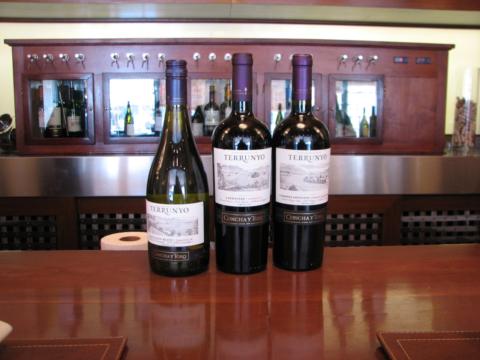The latest installment of wine lover Andy Rompel’s excursions in the world of wine: My last trip to South America couldn’t have been more timeous. I was lucky to return to South Africa just before the Puyehue‘s outbreak caused South American air traffic to go into hibernation, just as Europe did last year, when Iceland’s Eyjafjallajökull erupted. Difficult names to remember, I understand.
Still I got to taste a couple of good wines in Brazil and Chile, the countries I travelled to. Since Brazil doesn’t produce much good wine to speak of, I chose to order Argentinos, whereas in Chile I did not want to upset the national pride and strictly stuck to los locales.

One of the sommeliers in the tasting room of Concha Y Toro priding himself in front of the Marques range.
Only a few restaurants were visited in Brazil, amongst them Porcão in Belo Horizonte and Pequiras in Goiania. On both occasions I drifted between 2007 Chilean Cabernet Sauvignon and Argentinian Malbec. At Porcão we went for Angélica Zapata Malbec2006, one of the more distinguished versions of this rather harsh grape when cheap, but very refined and sophisticated in the more up-market range. At Pequiras I chose a Chilean Cabernet Sauvignon, the Terra Noble Gran Reserva 2007. It is of truly noble terroir, and soon became the table’s favourite. Big fruit was supported by a rich aromatic nose, indicative of a super 2007 wine.
Santiago de Chile is a fantastically organised city where everything works, arguably the best capital in South America. Included in this verdict is a huge variety of restaurants representing all kinds of food from around the world. Chilean’s favourite cuisine, however, is Peruvian. The manifold of Peruvian restaurants usually prides itself in fantastic seafood, very often as a main course, but almost always as a starter. So we followed suit at the Astrid Y Gaston restaurant in the older part of the Providencia suburb and ordered a variety of seafood starters.That cried for a worthy white wine and,more so in the evening, for a bodacious Chardonnay. Our choice was the Montes Alpha 2009, which disappointed slightly as Montes is one of the superstar winefarms in Chile and the Chardonnay did not have enough body, mouth feel to compliment the stunning seafood. We followed the Chardonnay with a Montes Alpha Syrah 2007, an outstanding wine from an exceptional year. 2007 was the finest in the recent past of Chilean winemaking. The wines are even more aromatic as they usually are, with bonbon flavours close to artificial. As Chilean wine does not contain much tannin, these super 2007s are already very drinkable now.
On the next occasion we followed the sommelier’s recommendation by choosing an Amplus Cabernet Sauvignon 2007, which follows in a similar mould to all others from 2007, exhibiting rich flavours supported by subtle oaky flavours. The final evening found us ordering steak which was complimented by (again a 2007) Morandé Cabernet Sauvignon Gran Reserva from the quality-guaranteed Valle de Maipo, an excellent choice with the hearty steak.
Not too far outside Santiago, and only a 45min bus ride away is the well-known Concha Y Toro wine farm. Concha is a very professionally managed wine farm geared at wine tourism on a more sophisticated level. It is well-known for its Casillero Del Diablo red, a medium quality wine at a very fair price, and available all over the world. A tasting of their finest revealed much higher quality, especially in the Don Melchor 2007, a blend of superb balance and elegance, also at a slightly elevated price. Value for money was the Terrunyo range, and here the outstanding wine was the Carmenere 2009, which actually had a bit of a Merlot taste, its potential ancestor before the Phylloxera pandemic, which spared Chilean vineyards about 120 years ago.

The Terrunyo range at the tasting room at Concha Y Toro.



